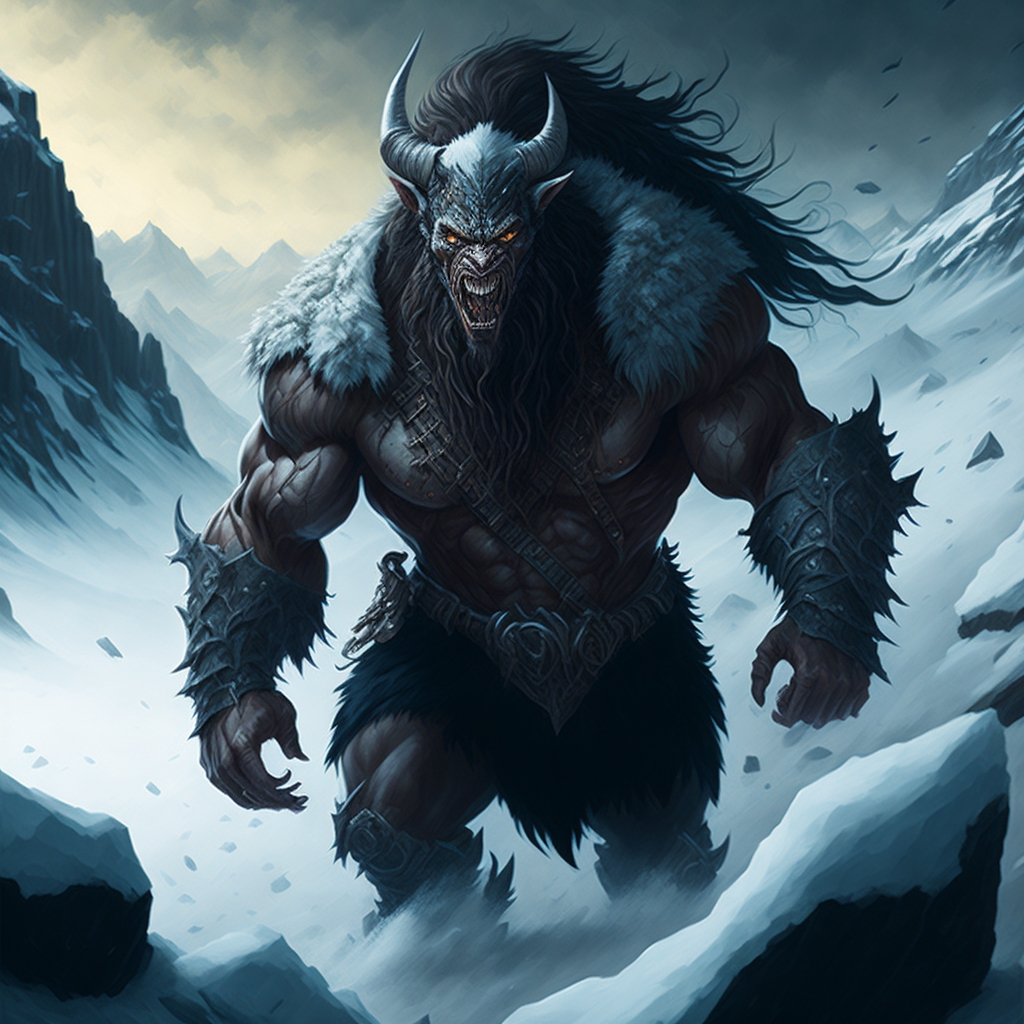
The Dravuri, or as they are known in the common tongue, “Darkbloods” are an aggressive, barbaric race that inhabit the Southern Wastes. Though considered profane, brutish, and uncivilized outcasts by the other races, few outsiders are actually privy to their true way of life. No one save for the Darkbloods are capable of living in the Southern Wastes for extended periods.
To survive in their harsh environment, they exhibit a number of specialized adaptations. This includes shaggy, thick fur, bounded feet resembling hooves, and giant horns for impaling lesser prey. Darkbloods, especially the larger ones, have two pairs of horns: a pair of stubby horns that appears at birth and a much larger second pair that appears after the onset of puberty and is specifically used for impaling and fighting.
Darkbloods come in all shapes and sizes, from their smallest beasts to their greatest behemoths. One Darkblood is formidable, but their strength truly lies in their numbers, which can be considerable around the Wastes. This great landmass extends very far in most directions, and, indeed, the Dravuri were the major reason how a map for the Wastes was even charted.
The Darkbloods are known to rely on their senses and instinct more than pre-thought. This may be why so many other races think of them as less intelligent. However, such a behavioral adaptation may be a necessity in an environment so scarce of resources as the Southern Waste. A moment of hesitation can mean the difference between life and death in this icescape.
In terms of diet, the Darkbloods are omnivorous, which is overlooked lots of times. They were always initially seen as carnivorous due to their overall nature and adaptations, but due to the overall scarcity of “moving food” in the Wastes, they have evolved to become omnivores and regularly eat plant matter as well whenever they can get it.
Darkbloods are insanely loyal to their tribe, their family, and their homeland. There is nothing more important to them than these three aspects. They defend this trinity with much more than their life— their whole being, their whole existence. It is said that if you manage to make an ally with a Darkblood – a good alliance – then you have earned the most loyal companion you’ll ever have in your life.
Darkblood naming practices are very unique. Instead of common two-word naming systems, the Darkbloods follow a method involving only one word with two sections divided by an apostrophe (‘). The section to the left of the apostrophe is the Darkblood’s name and the section to the right is their title in Dravurian (language of the Dravuri). Titles are carried on from generation to generation and act as surnames. The letter “t” acts as an “and” between two titles when two bloodlines are linked and it forms a fused version of the two. An example of a Darkblood name is “Gerok’Altorun”. The Darkblood’s name is Gerok and his title is Altorun or “the Swift and Decisive”. Gerok’s bloodline is a fusion of the Al and the Orun bloodlines, which mean “Brutal” and “Valorous” respectively. Remember that in collective sounds like “th”, the “t” is not counted as a conjunction.
i) The Darkblood “Empire”
Overview
There exists much fear in settled regions neighboring the Wastes of a possible Darkblood invasion. However, this fear is unfounded for the Darkbloods really do not care about expanding their territory. Sure, there is plenty of conflict between tribes but they have never thought of expanding their collective “Empire” beyond the Southern Wastes.
That being said, the Darkbloods have admitted to being in a greater empire – the Darkblood Reach, as they call it. However, this is purely for record-keeping and they still follow a tribal society. Their love extends only to their tribe and maybe their allied tribe(s).
In ways of civilization, the Darkbloods build tribe headquarters and other structures to mark the territory of their tribes but refrain from building regularly. Because of this, anything more than rural settlements is rare in the Darkblood Reach. This is because of both the difficulty in planning and building at a large scale in a place like the Southern Wastes and the fact the energy and time spent could be better used in more pressing aspects relating to survival.
Government & Tribes
The Dravuri follow a form of government known as a “Warocracy”. Some races suspect the Darkbloods don’t have a government at all and use “Warocracy” as a means to hide it, but it begs the question, “Why would the Darkbloods hide this?” A Warocracy revolves around war and conflict to decide the next Lord General, referred to as the Zai’Tark, who oversees decisions for the entire Darkblood race and listens to the opinions of all tribes.
The Lord General is generally respected by all Darkbloods, yet some small tribes may detest his interference in their lives and thus hate the Lord General with a passion. Over the Darkbloods’ history, these tribes have come back many times and orchestrated many revolutions, very few of which had any degree of success.
A tribe, in the concept of the Darkbloods, is a large group of Darkbloods that have descended from the same common ancestor and follow a common goal that has been passed down their collective lineage. This is a prime reason why their bonds are so strong. They treat their fellow tribe members as a family because they widely are.
A tribe consists of specific ranks which have been organized after a conference hundreds of years ago which has decided a universal hierarchy for all tribes. The hierarchy of a Darkblood tribe is organized in this way:
- At the absolute bottom are the Sanakros. They are tribal exiles who have either been shunned from the tribe’s premises for continued violation of their guidelines, have performed an act that is beyond redeemable, or enslaved to the tribe as a whole. As such, they are looked down upon by all other tribe members.
- Above the Sanakros there are the Bronks. They are the most common unit of a Darkblood tribe. In larger ones, their numbers are in the hundreds or even thousands. Their main work is battle and menial work.
- Above the Bronks are the Masteks. The Masteks are much more knowledgeable than the average Bronk and are well-versed in things like spirituality, strategy, and leadership. They often become war-scholars or commanders of their tribes.
- Above the Masteks are the Udraal. The Udraal are their tribe’s elders who oversee most affairs and give advisory support to the newer generations. Older Dravuri go through a short ceremony and then become Udraal, guides to the younger generations.
- Above the Udraal are the Ailur or the High Advisors. They are the high ministers and governors, who support the Nai’Tark either in some close way, either directly or indirectly. They have sworn an oath to serve the Tribefather for life and after which the bond between the Nai’Tark and his group of Ailur is brotherly and unbreakable.
- At the tribe’s helm is the Nai’Tark or the Tribefather. As generations pass, new Nai’Tarks are chosen through a more or less monarchical method through which the descendants of the tribe’s original founder are all gathered and tested through a variety of factors like strength, intelligence, and reputation. Each descendant is honored and if they fail the test, they will retry it eventually and each descendant will get their chance at ruling eventually.
Each Darkblood tribe has its own unique culture which is gathered in the Darkbloods’ shared folklore. Instead of grand stories about high and great gods, they’re mythic tales that focus on the adventures and exploits of legendary Darkbloods, those among them who have power akin to demigods. Many of these tales may be real because of the sheer power and tenacity of the Dravuri.
Not all tribes are united to each other. Almost all the time, political intrigue and tension are happening between warring tribes and groups of allied tribes against other groups or many tribes against one. There is unrest all over the Southern Wastes once in a few years, resulting from plots and campaigns stretching all over the Reach. Darkblood folklore continues to grow as all of these things are converted into stories.
Tribes either agree to the Tribe Convention (Aghr’Tikal) or not. The Aghr’Tikal is a general set of codes that governs the Dravuri way of life. Following the Aghr’Tikal is completely optional, but since so many tribes follow it, it’s become a stereotype for the best and most prosperous tribes to be following it.
The above-given phenomenon also gives way to the Dimzr’Nai or Dark Tribes. These tribes are akin more to crime syndicates than collections of settlements. They often enjoy causing chaos and are the predominant cause of war in the Reach. The Dimzr’Nai do not follow the Aghr’Tikal, thus the previously told stereotype about the Aghr’Tikal has been made.
ii) Sub-Factions
The Darkblood Reach is divided into many different tribes, minor and major, as stated before. There are in fact so many tribes that fluctuate in number due to constant war, collapsing of tribes, and the formation of new ones. Due to this, it is not possible to make a definitive list of all the Darkblood tribes. This list records their more stable and prominent tribes which scholars expect are not going to dissolve any time soon.
1. Storusann Tribe
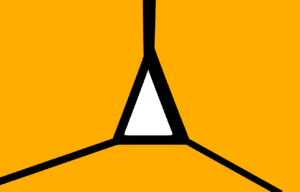
Founder: Staban’Rosstfal (Staban the Immortal and Valiant)
Current Nai’Tark: Hokthar’Yath (Hokthar the Ironheart)
No. of Members: ~29,100
The Storusann tribe is perhaps one of the oldest and most honorable tribes of the Dravuri. Their numbers are the greatest and their members are the most valiant of the Darkbloods. They occupy a large amount of land directly south of the Heartland.
The Storusanns have led many crusades and wars of attrition to capture as much land as they can to appease their ancestors. Their culture and tradition revolve around their elders and ancestors, and they value them more than any other tribe. Their ancestors were the best of the Darkbloods, the equivalent of demigods, and they believe they have to be respected accordingly.
While the Storusanns are fearless, strategic, and undoubtedly lucky on certain occasions, their main flaw is that they quite literally worship their ancestors and forefathers, straying from the commonly agnostic pattern of Darkblood tribes. They shed gallons and gallons of blood monthly in their ancestors’ name, and exile any heretics (Mudurasin) who dare to slander their forefathers’ names.
The tragic part of the Storusann tribe is that Staban’Rosstfal, its main founder, was one son out of three. He originally intended for his tribe members to focus on the present and the future, not to dwell on the past. When their father died, the question came upon them: who was to inherit the ashes of their father’s tribe, which had fallen during the War of Mount Khallagh?
The war for the throne was long and drawn out. Tribe members turned on each other and entire clans collapsed. Staban had to deceive his brothers to seize the throne for the greater good… having one ruler and all potential rulers dead would end the war. However, after he founded the Storusann tribe, his brothers stole the throne from him in a series of wars of attrition, then shifted the ideals of the tribe into worshipping the old. Staban tragically died fighting for his throne.
Today, the Storusann tribe is a formidable force, striking fear in the worst of opponents. Their history may be outlined in blood, but their ways are still honorable and undying through thousands of years.
2. Malngard Tribe

Founder: Stegyr’Amagh
Current Nai’Tark: Lostur’Amagh
No. of Members: ~27,700 –
The Malngard Tribe is a tribe of brotherhood and trust. It is held together incredibly tightly thanks to its existence as a massive joint family instead of a large, centralized unit with multiple Dravuri choosing to join.
The Malngards are secretive in their ways and often resort to ranged combat and strategy. All in all, they are one of the only tribes to consider long-term diplomacy that isn’t part of a greater plan. They control an amount of land that they very rarely fight to expand; they rather fight to defend it.
The Malngards, like the Storusanns, have a sort of semi-theological religion but with one key difference. Instead of worshipping their ancestors, they worship the land on which they live. Compared to the grueling cold and snow of the Southern Wastes, their land is known to be warmer and even suitable for limited agriculture in the summer months.
The Malngards are a set of Darkbloods that follow laws and rules in almost every aspect of their lives. For virtually everything imaginable, there are specific rules and important guidelines, all given in the Malngards’ ancient and massive tome known as the Armus-Ungr, their religious book.
The Malngards’ history is stained with neither blood nor betrayal, but instead sweat; the tribe was forged by renegades, outcasts from all other tribes, and the founder had to juggle defending the little land his family had and organizing a tribe. Eventually, once his family started expanding, things became easier because they were able to source soldiers from their clan members, mostly distant relatives like grandsons of brothers or cousins.
The Malngard tribe could be argued to be the most ethical tribe of the Dravuri, but in all honesty, the Malngards ultimately do what they have to do to survive, no matter the ethicality or morality of what they do. Their religion is incredibly important, and each Malngard could be seen (slightly negatively) as a religious zealot.
It is natural for some to most Malngards to practice folklore as a profession; they are the only tribe that has bards and storytellers, as they are genuinely very interested in their semi-theological religion.
The Malngards hold their fortress and their land to the far east of the Southern Wastes, just south of the Rachi Steppes. Warm wind blows southward towards them and the fertility of the Steppes seeps into the Malngardian land. This has made the Malngardian land substantially fertile… as compared to the other dead land of the Wastes. Small patches of grass can be seen here and there as well. Because of this, tribal alliances are commonly made with the Malngards for a steady stream of food. However, this has also resulted in some “food raids”, most of which have been fought off with the loyal Malngardian infantry.
3. Uzarus Tribe
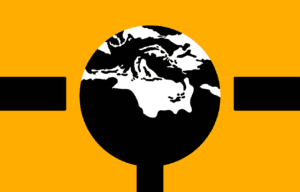
Founder: Mezvur’Yokolik
Current Nai’Tark: Azrodin’Yizmir
No. of Members: ~16,540
The Uzarus Tribe is the tribe of the Dravuri known for its wealth and civilization. It is the merchants’ guild of the Darkbloods, a motley band of traders and secret thieves among them that have come together to uphold the Darkblood economy.
The Uzarus Tribe is also a diplomatic association. This is aided by the fact that nobody fights it. It’s the source of the vast majority of goods other than food (which is accredited to the Malngards) and they are allied with essentially every tribe other than the Dimzr’Nai (“renegade tribes”).
Because of this, the Uzaruses believe themselves to be of a higher station than most other tribes members, which they secretly call the “Lower Tribes” or “Zutvr’Nai” behind the back of the Zaretvan (Governmental Association). Even the lowest in the Uzarus class-ladder are termed as “higher class” compared to the Dravuri of other tribes.
Unlike all other tribes, the Uzarus tribe has observed the workings of foreigners in a system known as “slavery”— servitude of an individual that does not receive pay. Hearing this, the Uzaruses began to implement a remarkably similar system in their tribe-regime which included slaves that were either Sanakros or war prisoners.
The Uzaruses are looked down upon secretly by the more noble tribes like the Malngards. It is clear to them that the Uzaruses are snobbish, self-centered, and insensitive. They deem relations with them worthless but keep one for political reasons. In fact, they manufacture about 97% of goods themselves or from outside rather than depending on the Uzaruses for too much of their goods.
The Uzaruses, in a totally neutral viewpoint, have grown soft over millennia of sitting back on their golden thrones and watching their stashes of money grow without them lifting a finger— their workers do all the finger-lifting, and only the higher Uzaruses know that they pay their workers a tad bit less than one would consider enough for the work they do… they gaslight their workers into believing they’re being paid generously, more than enough.
To the Uzaruses, their money is their god. Technically, their viewpoint is atheistic, but they are such Darkbloods that they unofficially worship their coins. While it may seem so, there are a few noble Dravuri in the Uzarus Tribe, like the great Azrodin’Yizmir who is the current Nai’Tark or Tribefather of the Uzaruses.
The Uzaruses hold their stronghold, or rather a city around the middle portion of the Southern Wastes, not too far down from Slaver’s Coast from where they trade goods [and enslaved people] with merchants of other races.
The Uzaruses’ history is marked neither with blood, nor betrayal, nor sweat, but rather… coins. The richest Darkbloods, who happened to be the most prosperous traders in the Wastes, banded together hundreds of years ago to establish an economy in the Darkblood Reach similar to that of the Northlands.
4. Alramun Tribe

Founder: Gulveth’Dessamun
Current Nai’Tark: Assad’Hajvari
No. of Members: ~15,980
The Alramun Tribe is perhaps the most orderly and scholarly tribe of the Dravuri. They live to further their knowledge of science and mathematics. They were formed from anti-conformists and reformists that denied the dominant Darkblood regime and chose to make their own one, defiant to the Aghr’Tikal.
The Alramuns are moral, noble, and diplomatic, although they have a strong and intelligent army ready for any defense of Alramun territory. While most other tribes focus on expansionism and battle, the Alramuns have always diverted their focus to the quality of life and knowledge above all.
The Alramuns have made thousands of discoveries over the massive history of the Darkbloods and have almost always distributed these discoveries to all tribes they deemed deserving. As for gunpowder-based weaponry (which is one of their newer discoveries), they have chosen to keep it to themselves as of now.
During the tension of war, the Alramuns are cold and calculating, often considering the more immoral methods of war. However, unlike other tribes, they keep these methods as a last resort and instead try to seek out other methods to prevent or delay war.
The Alramuns are stubborn and innovative, and this may be seen as a genetic trait. In reality, the Alramun Tribe was formed from a vibrant group of young Dravuri seeking to advance the technology of their race as a whole. As things began to get more complicated, they decided to make the choice of keeping some inventions to themselves.
The Alramun Tribe’s religion revolves around a mechanical, scientific god, Hastavuun, who is said in the Book of Darkblood Religion to have provided the Alramuns with their wisdom and innovation, and He was also said to have provided all living creatures with minds.
The Alramuns have, in fact, developed a type of automaton: using the mystical knowledge of the Dvergr, they have learned how to merge the ‘essence’ of lightning with a metal body. However, this is quite hard to do and only the most highly skilled tribe artificers can successfully accomplish this feat. These automatons are used to provide mostly unending military and general services to the Alramun people.
The Alramuns are regarded with a generally good attitude by the vast majority of Darkblood tribes. However, in an effort to get access to some of their more well-guarded technologies, there have been recorded attempts at sieging their strongholds, which have almost always been pushed back with the Alramuns’ outstanding technology.
5. Zamuron Tribe
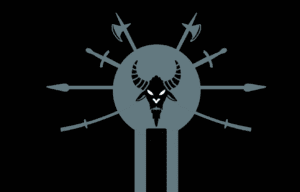
Founder: Lakurus’Yath, the first Zai’Tark/Lord General
Current Zai’Tark: Onkoros’Yathtar
No. of Members: ~23,890
The Zamuron Tribe is by all means the greatest tribe of the Dravuri to ever exist, even rivaling the great and old Storusann Tribe. This tribe is also known as the “Government” of the Dravuri to outsiders as it oversees all other tribes.
The Zamuron Tribe is impartial and all-consuming. It has a territory of its own, but it is undisputed and consists of two strongholds positioned horizontally beside each other east of the Uzaruses’ capital city. No tribe disputes it except the foolish and the weak; those rebel Dravuri that think themselves greater than the great tribes consisting of thousands of Darkbloods.
The Zamuron Tribe has spoken as per Darkblood law that each warrior of each tribe is obliged to serve in the Zamuron Tribe’s greater army which defends the entire Darkblood race when threats from other races come by. This is quite rare, but once in a blue moon, when a Human or a Dvergr tyrant wishes to extend their empire into the Wastes, they get severely beaten back by the brutality, strategy, and sheer number of the Dravuri who have banded together to defend their collective homeland, the Wastes.
The Zamuron’s Nai’Tark or Tribefather is renamed to Zai’Tark or Lord General, the Dravuri warlord picked through a monarchy that has proved more valorous than the best of every tribe. Every tribe member of every tribe is answerable to the Lord General and in turn, the Lord General is answerable to every tribe member of every tribe.
The Zamuron Tribe was formed at the end of the Vadan Vinisk or “Wars of the World” when the Dravuri were at war with foreign races. The Darkblood Reach was in pure havoc and as the tribe members begged silently for law and order, Lakurus’Yath, only one of the noble Dravuri warlords of myth and legend, formed the Zamuron Tribe as a governmental body, named himself Zai’Tark, and pledged to defend all the Dravuri and allow the gods to claim him and bring him to Hell (or “Etrak”, as the Dravuri know of it) if he ever ceased to continue this pledge.
Ever since then, the Zamuron Dynasty was formed, and while many lesser governors were appointed, the monarchy remained exactly the same throughout Darkblood history; the selection process stayed the same and required each potential Lord General to excel greatly in each and every school of combat, thought, strategy, and ruling. Thus, the Lord General would be picked from the best of the best of the best warlords of each Tribe and also the newest descendants of Lakurus’Yath.
The Zamuron Tribe is perhaps the noblest and most moral tribe of all the Dravuri tribes in existence. It is only immoral when it needs to be, and most of that immorality is directed towards foreign threats, and the rest to rebel Dravuri anarchists that only wish to see the Darkblood Reach fallen.
To be a governor or royal guard (Zalvar) of the Zamuron Tribe is almost every young Dravuri’s dream, and rightly so. These warriors are the best of the best, not quite as powerful as the Zai’Tark, but are as devastating as a ~3,500-soldier-strong army of Dravuri can get.
The Zamuron Tribe also has Dravuri mages that have learned from Dvergr and Human archmages and have become incredibly adept and knowledgeable in the arcane arts. They are employed as battle-healers, warlocks, and court farseers. They are the few Darkbloods that can successfully utilize the arcane powers and thus are very highly regarded in Dravuri society.
iii) Dravurian: The Darkblood Language
The language of the Darkbloods is strange and unique. It is known to them as Dravuri but to avoid confusion, outsiders to the Southern Wastes refer to it as Dravurian. It will be referred to as Dravurian here.
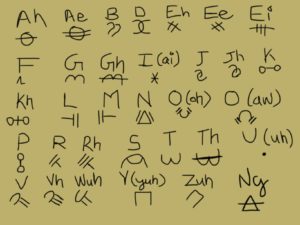
Starting from the alphabet, it is completely distinct from other Known World scripts. It is composed of a mix of angular symbols and curves. The more angular symbols have been carried over from the “First Edition” of the Dravurian alphabet, which has been revised twice in total, making the current alphabet the Second Revision Alphabet. This is, as stated by many scholars, the final revision and the only reason revisions have been done is to correct severe grammatical discrepancies or for more versatility.
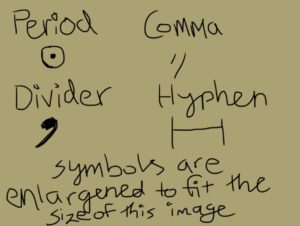
The phonetics of Dravurian is entirely centered upon being clear and precise instead of having several pronunciations for the same letter. The sentence structure is Subject-Object-Verb. “Commas” in Dravurian are called Zangkurs and are used to separate the three sentences in an Aurit or a Sentence-Group. Aurits are separated by a period or a Yadaas.
Many words in Dravurian are divided into two parts. These parts are divided by a Divider or Lotkur. Some words are, in fact, divided into three parts, although these are quite rare because they were the few words carried on from previous Alphabet Editions.
Hyphens or Aatkurs are used as “…”’s, for emphasis and pacing. The number system is fundamentally unique but for larger numbers it is coincidentally similar to that of the other foreign races. 0 is repeated after a meaningful number to show a greater number.

Dravurian is quite hard to translate to other languages because it was meant to be spoken by the Darkbloods’ layered and special tongues which can touch parts of their mouths like no other race. Other than that, it is said that there are more words in Dravurian than all the other languages in the Known World combined just because of the sheer amount of dialects and regional sub-languages that vary from tribe to tribe.
Dravurian also does not have many addenda or revisions in its entire history because scholars who have dedicated their lives to studying Dravurian are a small minority. In addition, as stated above, one of Dravurian’s main ideas was to be easy to understand, precise, and to the point.
Tribes, along with their own religion and dialects, sometimes have a nearly totally altered form of Dravurian that makes it even harder to relativize proper translation of the language into the more versatile languages of races foreign to the Dravuri.
Dravurian by default is meant to be literal rather than metaphorical. However, after the Renaissance-like boom in art and culture in the Darkblood Reach, Dravurian has been manipulated by Dravuri scholars and creatives to represent metaphors and phrase sentences more beautifully.
iv) Important Events in Dravurian History
The Darkbloods have a rich and extensive history, being passed orally through generations, with tales of their ancient heroes, mystical traditions, and the enduring struggles of their people. Given below is a simplified chronology of the major events in Darkblood history, only those that changed their culture’s history in the most profound way.
Emergence of the Darkbloods: This is the most mysterious and unknown part of the Darkbloods’ history. Some tribes believe a greater entity created them, other more secular-minded ones believe a more evolutionary origin for the Dravuri, including a possible hypothesis of being a sub-species of the Weria.
Revolution in Community & Warfare: This started about five hundred years after the Dravuri emerged as a distinct culture. The Darkbloods formed communities and began to survive together, forming very primitive versions of tribes and advancing technology for warfare against other groups.
Age of Unrest: This era of Darkblood history lasted for about 750 years. The groups of Darkbloods that formed in the first Revolution still carried on and war between these primitive tribes carried on unendingly for many centuries.
Wars of the World: This mostly overlapped with the Age of Unrest while foreign races tried to expand into the Southern Wastes and fought with the Dravuri.
First Great Enlightenment: This event happened just at the end of the Age of Unrest. Slowly but surely, the Dravuri began to lean towards order, law, scholarship, and strategy. At this point, the Dravurian language was very well-developed and the Aghr’Tikal was formed by what would become the Zamuron Tribe. The current prevailing Tribal institutions were also formalized.
War of Mount Khallagh: After this fateful war, another long war started which would culminate in the formation of the great Storusann Tribe.
Second Great Enlightenment: This event could be compared to the Renaissance. Sure, scholarly education was acknowledged, but scholars were still a minority. By the start of this, scholars became much more common, and more complex forms of art began to emerge.
Revisions of Dravurian: The Dravurian language was revised and modified as writing shifted from on stone tablets (angular alphabet) to much finer Kharkata wood paper (more rounded alphabet). Both revisions happened in fast succession to each other.
Age of Tribes: The current age. The Dravuri economy is booming, tribes are being formed and destroyed and the best tales are being told.
v) Conclusion
The Dravuri are a great and ancient race of what would seem like brutes to outlanders but, in fact, are a complex and advanced species that are as powerful in their militaries as they are in their intellect.
The physiology of the Darkbloods is unique and adapted to their frozen wasteland of a home, the Southern Wastes. This makes them very resilient and powerful. They can endure quite literally any type of terrestrial environment.
The Darkbloods’ “empire” is known as the Darkblood Reach. It follows a form of government known as a “Warocracy” in which the empire is divided into tribes and is overseen by a greater body known as the Zamuron Tribe.
Each tribe of the Darkbloods has its own culture, religion, heritage, and dialect in the Dravurian language. They either comply with the Aghr’Tikal (the widely accepted tribe hierarchy system) or not. The major tribes of the Dravuri are the Storusann, Malngard, Uzarus, Alramun and Zamuron Tribes.
The Dravurian language is mostly simple in its rules but has a monstrous amount of words, dwarfing even the most complex of Known World languages. It has undergone two revisions, has its own alphabet and its number system is coincidentally similar to that of foreign races.
The history of the Darkbloods is grand and epic in its proportions and is spread over many thousands of years. Darkblood culture, scholarliness, and strategic prowess flourished only after the Great Enlightenment.
This entry was made by community member Sir Hanroq of Rusted Sky. Flag art by Lord Grunwalder.